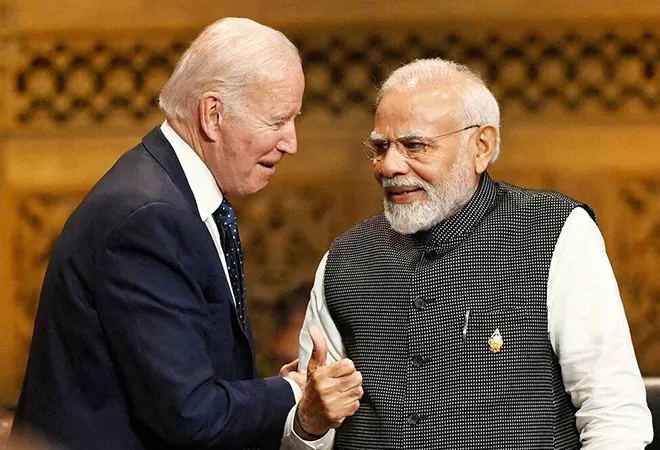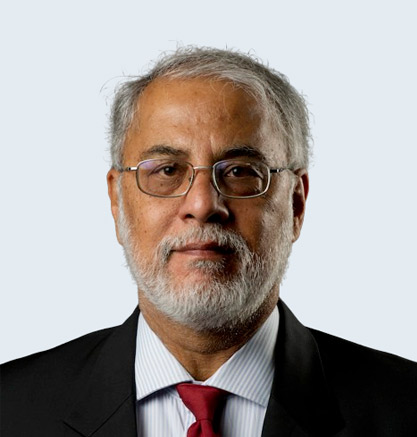-
CENTRES
Progammes & Centres
Location
Prime Minister’s visit to the US could prove to be pivotal as it aims to boost India-US economic and defence ties

There is a lot of excitement over Prime Minister Narendra Modi’s state visit to the United States from 21–4 June. Some say it is the most important visit by an Indian PM to DC. Others have termed it as Modi’s Deng Xiaoping moment which could transform India’s geoeconomic and geopolitical fortunes.
By all accounts, its principal outcome will be laying the foundations of the India-US economic relationship, especially the defence technology sector.
Key discussions for this took place at the end of January when India’s National Security Advisor Ajit Doval visited Washington for the formal launch of the Initiative for Critical and Emerging Technologies (iCET) with his counterpart, Jake Sullivan. The initiative had been announced in May 2022 when President Joe Biden met Modi in Tokyo.
At the launch of iCET, a White House statement said that the two countries were set to expand their “strategic technology partnership and defense industrial cooperation” not just between governments, but businesses and academic institutions of the two countries.
The capstone of the visit will be the announcement relating to the licence manufacture of the GE-414 jet engine to power Indian fighters.
The capstone of the visit will be the announcement relating to the licence manufacture of the GE-414 jet engine to power Indian fighters. The two sides will also formally launch the INDUS X initiative to promote “partnerships between the US and Indian defense innovation section”. There may be an announcement relating to the acquisition of 18 MQ-9 Reaper armed drones. Important decisions relating to intelligence sharing and some joint defence activities may not be disclosed at this stage.
A great deal of planning and effort has already gone into the visit. Earlier this month the US Secretary of Defence, Lloyd Austin was in New Delhi to conclude discussions on a roadmap for Indo-US Defence Industrial Cooperation with his counterpart, Rajnath Singh. The two also referred to the Advanced Domains Defence Dialogue that took place in May to expand cooperation in all domains relevant to security, especially space and AI.
A key element was put in place on 6 June with the launch of the India-US Strategic Trade Dialogue in Washington DC . Foreign Secretary V.M Kwatra led the Indian delegation whose objective was to facilitate the development and trade in “critical technology domains” which include semiconductors, space, telecom, quantum technology, AI, defence, biotech, and so on. Steered by Alan Estevez, the top US official dealing with export control and compliance at the US Department of Commerce’s powerful Bureau of Industry and Security, the dialogue was aimed at ensuring that the thicket of US regulations does not choke the process.
A week before the Modi visit, Jake Sullivan was in New Delhi to put the finishing touches. Later he and his Indian counterpart, Ajit Doval, participated in a symposium organised by the Confederation of Indian Industry (CII) on advancing the iCET. In his remarks, Doval summed up the Indian thinking on the issue. He said he had been somewhat sceptical at the outset, “I was not sure whether the idea would take off.” But having seen the response of governments, industry, scientists, and research institutions, “I am much more confident and hopeful.” He said that iCET would provide an “orbital jump” in the Indo-US relationship.
Steered by Alan Estevez, the top US official dealing with export control and compliance at the US Department of Commerce’s powerful Bureau of Industry and Security, the dialogue was aimed at ensuring that the thicket of US regulations does not choke the process.
The current developments need to be seen in light of the half-century effort by India and the US to establish a technology-trade relationship. Beginning with the Gandhi-Reagan Science and Technology Initiative and the memorandum of understanding (MoU) on Technology Transfer of 1984, through the India-US Science and Technology Joint Commission (2005) and the Defence Technology and Trade Initiative (2012), the experience has been underwhelming.
A lot of that had to do with the differing goals of the two sides, some of it was the natural outcome of the enormous asymmetry between them—India seeking US technology and trade to move up the economic ladder, while the US wanting to incorporate India into its global economic framework, though currently, the emphasis is on defence and security ties with a view of containing China.
Those seeking to work out the new terms and conditions for the Indo-US technology partnership are keenly aware of this. And though at the rhetorical level, the relationship may be sold as a “no limits partnership”, on a practical level, there are bounds, especially on the technology transfer front arising from India’s inability to absorb certain technologies, and from the US side on the need to protect some of them.
There is, therefore, a need to separate the aspirational outcomes from the real ones. For this, we need to examine more deeply the drivers of Indian and American policies. Today, New Delhi occupies a favoured place in Washington’s geopolitical worldview, but it does so within a larger American perspective that has been evolving as the new Washington Consensus. Since the US remains the foremost military power, its current goal is focused more on the need to rejig US domestic and international economic policy to shore up the American global primacy against the most formidable challenge of China.
New Delhi occupies a favoured place in Washington’s geopolitical worldview, but it does so within a larger American perspective that has been evolving as the new Washington Consensus.
The US is taking what could be transformative steps in its economic and security policies, emphasising the importance of the latter. In April, in a speech at the Brookings Institution, Jake Sullivan called for the forging of a new consensus based on a modern American industrial strategy.
This would, first, focus on innovation and competition in areas like semiconductors, clean energy technology, and so on. Second, it would include American partners in building capacity and resilience. Third, it would seek to replace the existing trading system with “innovative new international economic partnerships” which would not focus on tariffs alone. The fourth pillar would be massive investments in emerging economies to develop energy, physical, and digital infrastructure by updating the operating models of existing development banks.
The last and key pillar of Sullivan’s plan was to protect America’s “foundational technologies with a small yard and high fence.” All high-tech and foreign investments would have to pass the stringent national security test.
This is an ambitious plan and it remains to be seen how it would work, and how and whether India would fit into this. New Delhi is seen as a partner in a number of key initiatives such as those related to supply chain resilience and clean energy technology. It can expect significant investments but they would be within the ambit of US rules and regulations and shaped by US needs. There would be no automatic special access to either US technology—or the US market—which is a major requirement for India’s economic growth.
The fourth pillar would be massive investments in emerging economies to develop energy, physical, and digital infrastructure by updating the operating models of existing development banks.
The US is already a major trade and investment partner of India. New Delhi has always welcomed greater commitments from the US high-tech majors whether for profits or in the name of supply chain resiliency. Equally, it needs US defence technology to address the yawning gap between Indian and Chinese comprehensive national power.
In this context, the approval of the licence manufacture of the GE 414 engine is important as is the promise of 100 percent technology transfer. The F 414 project will be an extremely demanding one and it may have been far cheaper to simply import the engine and have GE provide tech assistance to develop an engine for the AMCA. So far, India has only manufactured the Orpheus engine for the Gnat in the 1960s and RD 33 for the MiG21 and the AL 31P for the SU-30 MKI. In many cases, these were assembled from components supplied from abroad. India’s domestic programme for the Kaveri engine to power the LCA Tejas has been a failure.
The complication is that India’s aatmanirbhar technology ambitions run way ahead of its capacity. These become manifest in areas of sophisticated defence technology. Indian companies cannot simply deliver. You can be sure, in any case, that despite the licence to manufacture, there will be restrictions in the transfer of certain technologies related to the engine.
New Delhi is wary of any larger commitment to US defence plans, especially about China. This was evident in its response to the proposal mooted in May by the US House Select Committee on Strategic Competition led by Congressman Mike Gallagher that India be offered a membership in the North Atlantic Treaty Organisation (NATO) Plus 5 grouping. This grouping comprises NATO and five US allies in the Indo-Pacific—Australia, New Zealand, Japan, Israel, and South Korea.
Earlier this month, speaking on the nine years of Prime Minister Modi’s government, External Affairs Minister S Jaishankar categorically rejected the idea. “NATO template does not apply to India,” he said. Even earlier in April 202, speaking at the Raisina Dialogue, Jaishankar had said Quad was not “Asian NATO” and that India never had a “NATO mentality.”
US equipment like Boeing P 8I Poseidon and Sea Guardian drones have also been used for intelligence gathering along the LAC.
But there are other levels at which the Indo-US quasi-alliance can operate and these are reportedly under discussion. Amongst them are those relating to intelligence-sharing arrangements with the US and its allies. Already, there is a certain level of sharing information in the Indo-Pacific maritime domain. US equipment like Boeing P 8I Poseidon and Sea Guardian drones have also been used for intelligence gathering along the LAC.
According to reports, US intelligence tipped off the Indian Army about the Chinese plans to overwhelm Indian posts at Yangtse in December last year. The American information proved to be invaluable in the Indian ability to foil the Chinese attempt.
There are some suggestions that intelligence could be the area where US-India interaction deepens. In September 2021, the US Congress’ Subcommittee on Intelligence Operations asked the US Director of National Intelligence for a report on the Five Eyes intelligence sharing system and the opportunities and benefits of expanding the arrangements with India, South Korea, Japan, and Germany. Presumably, the report that had to be submitted by May 2022 has been written and remains classified.
Given this, the next logical step could be the establishment of joint Signal’s Intelligence data collection sites along the Sino-Indian border by the US National Security Agency and the National Technical Research Office (NTRO) There is some history here. The US and China had set up intelligence-gathering facilities aimed at the erstwhile Soviet Union in Xinjiang and Inner Mongolia in the 1980s. India and the US had their own venture in the Nanda Devi sanctuary in the 1960s where a nuclear-powered device was supposed to gather Chinese telemetry intelligence.
Manoj Joshi is a Distinguished Fellow at the Observer Research Foundation
The views expressed above belong to the author(s). ORF research and analyses now available on Telegram! Click here to access our curated content — blogs, longforms and interviews.

Manoj Joshi is a Distinguished Fellow at the ORF. He has been a journalist specialising on national and international politics and is a commentator and ...
Read More +